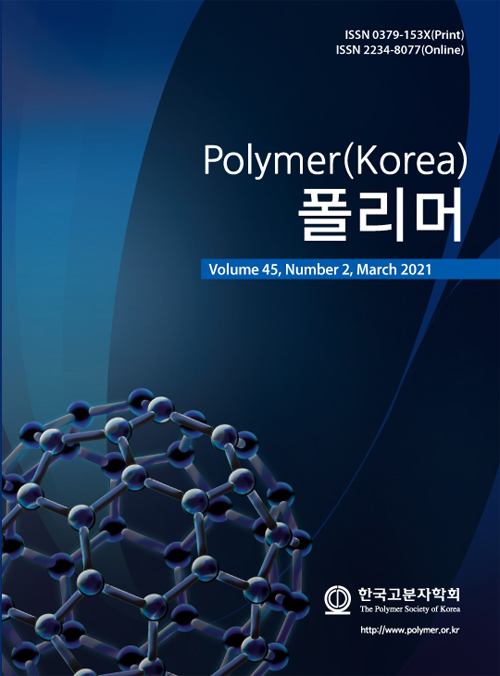- Cure Kinetics and Chemorheology of Epoxy/Clay Nanocomposites for Outdoor Use with Various Nanoclays
Division of Chemical Engineering, Dankook University, 126 Jukjeon-dong, Suji-gu, Gyeonggi-do 16890, Korea
- 나노충전제의 종류에 따른 옥외용 에폭시 나노복합체의 경화속도론 및 화학유변학
단국대학교 화학공학과
Reproduction, stored in a retrieval system, or transmitted in any form of any part of this publication is permitted only by written permission from the Polymer Society of Korea.
The curing behavior of silicone rubber modified epoxy/clay nanocomposites with various nanoclays was studied using a differential scanning calorimeter (DSC) and an oscillatory rheometer. The nanocomposites were prepared from the reaction of cycloaliphatic epoxy resins, silicone rubber containing amine functional group, anhydride hardener and nanoclay. The nanocomposites containing 30B of nanoclay had the largest amount of heat generated by DSC, and the rheometer test showed the shortest gelation time. The isothermal cure results were well matched with the modified Kamal's model. Therefore, it is thought that the nanocomposites for outdoor use in this study can be simulated the overall cure characteristics by applying a modified Kamal’s model
여러 가지 나노클레이에 대해 실리콘 고무로 개질된 에폭시/클레이 나노복합체의 경화 거동을 미분주사열량계(DSC)와 진동 레오미터를 이용하여 연구하였다. 지환형 에폭시 수지, 아민기를 포함하는 실리콘 고무, 무수 경화제, 나노클레이의 반응을 통해 나노복합체를 제조하였다. 나노클레이 30B를 함유한 나노복합체가 DSC 결과 발열량이 가장 컸으며 레오미터 결과 젤화시간이 가장 짧았다. 등온경화 실험의 결과는 개선된 Kamal 모델에 잘 부합하였다. 이에 개선된 Kamal 모델을 적용하여 본 연구에서의 옥외용 나노복합체의 전체적인 경화특성을 모사할 수 있으리라 사료된다
Keywords: silicone rubber, cycloaliphatic epoxy, cure kinetics, chemorheology, nanoclay
- Polymer(Korea) 폴리머
- Frequency : Bimonthly(odd)
ISSN 0379-153X(Print)
ISSN 2234-8077(Online)
Abbr. Polym. Korea - 2023 Impact Factor : 0.4
- Indexed in SCIE
 This Article
This Article
-
2021; 45(2): 219-227
Published online Mar 25, 2021
- 10.7317/pk.2021.45.2.219
- Received on Oct 4, 2020
- Revised on Dec 20, 2020
- Accepted on Dec 28, 2020
 Correspondence to
Correspondence to
- Sangmook Lee
-
Division of Chemical Engineering, Dankook University, 126 Jukjeon-dong, Suji-gu, Gyeonggi-do 16890, Korea
- E-mail: sangmooklee@dankook.ac.kr










 Copyright(c) The Polymer Society of Korea. All right reserved.
Copyright(c) The Polymer Society of Korea. All right reserved.